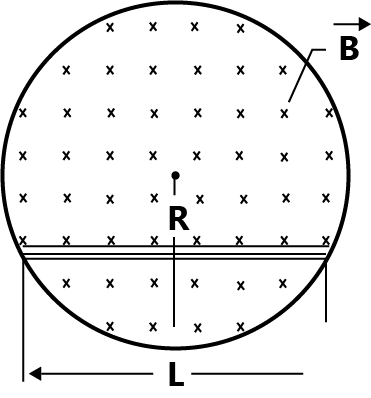
A uniform magnetic field of induction B fills a cylindrical volume of radius R. A rod AB of length 2l is placed as shown in fig. If B is changing at the rate $dB/dt$, the emf that is produced by the changing, magnetic field and that acts between the ends of the rod is:

(A) $\dfrac{{dB}}{{dt}}l\sqrt {{R^2} - {l^2}} $
(B) $\dfrac{{dB}}{{dt}}l\sqrt {{R^2} + {l^2}} $
(C) $\dfrac{1}{2}\dfrac{{dB}}{{dt}}l\sqrt {{R^2} - {l^2}} $
(D) $\dfrac{1}{2}\dfrac{{dB}}{{dt}}l\sqrt {{R^2} + {l^2}} $
Answer
218.7k+ views
Hint: First of all, we will calculate the area of triangle AOB. We will use the concept of rate of change of magnetic flux as emf or induced voltage in the cylinder. We will use $emf = A\dfrac{{dB}}{{dt}}$ formula to calculate the emf produced at both the ends of the rod.
Complete step by step answer:

Magnetic field of induction B:
It is defined as the number of magnetic field lines passing a unit surface area normally.
Emf: Rate of change of magnetic flux is known as emf. It is deNoted by $\varphi $. It is also known as voltage.
Mathematically, emf is an integral multiple of magnetic flux crossing area element dA.
${\varphi _B} = \iint\limits_A {B.dA}$
Differentiating on both the sides, we get
$emf = \dfrac{{d\varphi }}{{dt}}$$ = A\dfrac{{dB}}{{dt}}$
Magnetic field is confined in a cylinder of radius R.
Length of rod = AB = 2l
Rate of change of magnetic field $ = \dfrac{{dB}}{{dt}}$
According to figure;
Area of triangle AOB = A
Using Pythagorean Theorem,
$OC = \sqrt {O{B^2} - C{B^2}} $
OB = radius of circle = R
CB = half of length of rod AB = l
$OC = \sqrt {{R^2} - {l^2}} $
Area of a triangle $ = \dfrac{1}{2} \times base \times height$
$ = \dfrac{1}{2} \times OC \times AB$
$ = \dfrac{1}{2}2l\sqrt {{R^2} - {l^2}} $
$ = l\sqrt {{R^2} - {l^2}} $
Emf induced at the midpoint of rod AB is
$\varepsilon = \dfrac{{dB}}{{dt}}l\sqrt {{R^2} - {l^2}} $
Therefore, option A is correct.
Note:
If Pythagorean theorems have been used then $\sqrt {{R^2} + {l^2}} $ will not come in the solution. Option B and D will be wrong. If the length of rod is taken as l instead of $\dfrac{l}{2}$ then flux calculated will not be at mid-point. That’s why option A is the correct solution.
Complete step by step answer:

Magnetic field of induction B:
It is defined as the number of magnetic field lines passing a unit surface area normally.
Emf: Rate of change of magnetic flux is known as emf. It is deNoted by $\varphi $. It is also known as voltage.
Mathematically, emf is an integral multiple of magnetic flux crossing area element dA.
${\varphi _B} = \iint\limits_A {B.dA}$
Differentiating on both the sides, we get
$emf = \dfrac{{d\varphi }}{{dt}}$$ = A\dfrac{{dB}}{{dt}}$
Magnetic field is confined in a cylinder of radius R.
Length of rod = AB = 2l
Rate of change of magnetic field $ = \dfrac{{dB}}{{dt}}$
According to figure;
Area of triangle AOB = A
Using Pythagorean Theorem,
$OC = \sqrt {O{B^2} - C{B^2}} $
OB = radius of circle = R
CB = half of length of rod AB = l
$OC = \sqrt {{R^2} - {l^2}} $
Area of a triangle $ = \dfrac{1}{2} \times base \times height$
$ = \dfrac{1}{2} \times OC \times AB$
$ = \dfrac{1}{2}2l\sqrt {{R^2} - {l^2}} $
$ = l\sqrt {{R^2} - {l^2}} $
Emf induced at the midpoint of rod AB is
$\varepsilon = \dfrac{{dB}}{{dt}}l\sqrt {{R^2} - {l^2}} $
Therefore, option A is correct.
Note:
If Pythagorean theorems have been used then $\sqrt {{R^2} + {l^2}} $ will not come in the solution. Option B and D will be wrong. If the length of rod is taken as l instead of $\dfrac{l}{2}$ then flux calculated will not be at mid-point. That’s why option A is the correct solution.
Recently Updated Pages
A square frame of side 10 cm and a long straight wire class 12 physics JEE_Main

The work done in slowly moving an electron of charge class 12 physics JEE_Main

Two identical charged spheres suspended from a common class 12 physics JEE_Main

According to Bohrs theory the timeaveraged magnetic class 12 physics JEE_Main

ill in the blanks Pure tungsten has A Low resistivity class 12 physics JEE_Main

The value of the resistor RS needed in the DC voltage class 12 physics JEE_Main

Trending doubts
JEE Main 2026: Application Form Open, Exam Dates, Syllabus, Eligibility & Question Papers

Derivation of Equation of Trajectory Explained for Students

Hybridisation in Chemistry – Concept, Types & Applications

Understanding the Angle of Deviation in a Prism

Understanding Collisions: Types and Examples for Students

Understanding Atomic Structure for Beginners

Other Pages
JEE Advanced Marks vs Ranks 2025: Understanding Category-wise Qualifying Marks and Previous Year Cut-offs

How to Convert a Galvanometer into an Ammeter or Voltmeter

Understanding Centrifugal Force in Physics

JEE Main Marking Scheme 2026- Paper-Wise Marks Distribution and Negative Marking Details

Degree of Dissociation: Meaning, Formula, Calculation & Uses

Understanding Electromagnetic Waves and Their Importance




